By Victor Narro. Victor is the Project Director for the UCLA Center for Labor Research and Education, and a lecturer at UCLA Law School and UCLA School of Urban Planning
With the end of any chance for comprehensive immigration reform, the immigrant rights movement finds itself at a critical crossroad. The current humanitarian crisis of thousands of children in detention continues without any leadership from the White House and Congress to declare them as humanitarian refugees. At the same time, we must stop President Obama’s policy of massive deportations and separation of families.
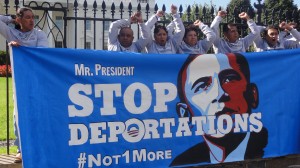
Not 1 More Deportation Campaign; Photographer: NDLON
What immigrant rights advocates are facing today is not unlike similar situations in the past. In 2007, we coped with the last failure to accomplish CIR while fighting off local initiatives like Secure Communities that threatened immigrant communities. In 2001 post 9-11, we went from a campaign for unconditional amnesty to defending against the impact of the Patriot Act and the creation of the Department of Homeland Security. With past unsuccessful attempts at CIR, we engaged in cycles of pointing fingers, shifting blame and attacking other strategies while defending our own.
As an immigrant rights advocate for 30 years and someone involved with previous efforts at CIR, I have seen the harm these cycles of shifting blame have caused the immigrant rights movement. In a blog last February, I wrote about advocates committing “malpractice” on the immigrant communities impacted by our strategy decisions, just as lawyers commit malpractice when they fail to exercise due diligence or are grossly negligent in the representation of their clients. I argue that the major crossroad where we find ourselves in the fight for humane immigration reform calls us to step back, reflect, and assess our strategies to create a more just and humane society for millions of immigrant families. If managed well, our next steps in this critical moment could bring greater solidarity away from a sometimes-fractious movement. At this crossroad, our leadership model must shift, or we risk gross negligence.
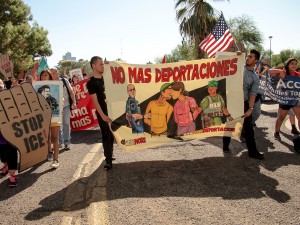
Photographer: Chandra Narcia
I argue for a new approach to move the fight for immigration rights forward. We should move forward together in solidarity and compassion to forge new strategies through a spiritual framework. What does this mean?
Though my own work is secular, I have often drawn from faith leaders’ examples to guide my approach. The spiritual inspiration of my life as an activist is St. Francis of Assisi, the peace activist of the Middle Ages. Eight hundred years ago, this humble person transformed his world and renewed the Catholic Church by simple but revolutionary acts of practicing his faith as it had never been practiced before. St. Francis was a man of peace who was known for building bridges of communication, understanding, and cooperation between warring people, groups, and nations. Francis lived during the highly turbulent period intense religious polarization with the Christian crusades and the inquisition. It was also the period of transition from a feudal society to a mercantile-based economy, which led to economic inequality, and oppression of the lower class. St. Francis led a social-justice movement for the poor and underprivileged during the Middle Ages.
The way immigrant rights activists treat one another must be as just as the justice we seek in the end. This framework of spirituality is the essence of my upcoming book, Living Peace: Connecting Your Spirituality with Your Work for Justice. I argue that embedded in the work of social justice activism are values that we find in different spiritual faiths like compassion for others, and I encourage social justice activists to embrace them in their daily work. As immigrant rights advocates, we have the foundation of spirituality within us from which we can approach the work together. We must look inward and ask not what we did wrong, but reflect on our work as immigrant rights activists drawing from our different spiritual values. Each of us can accomplish this through our own respective spiritual or religious practice or through a collective process of reflection that promotes inclusion and solidarity building. This spiritual framework relies on two principles from Franciscan spirituality: 1) interconnectedness; 2) leadership through humility.
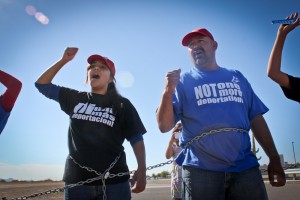
Eloy Detention Center – Arizona
Photographer: Chandra Narcia
Interconnectedness between all of us in social justice work is an important and indispensable part of an activist’s life. This is especially true in the immigrant rights movement where we find ourselves dispersed in so many different strategies and campaigns, and often disconnected from each other. St. Francis of Assisi, the peace activist of the Middle Ages, would spend long hours with each of his brothers, who formed the first band of followers of his teachings. He lived the heart-to-heart connections with his group of brothers. Similarly, in the movement for social justice, we are all interwoven – ourselves, our lives and our work. Francis had the capacity to go deep into someone’s heart and share the joy and sadness of that person. As immigrant rights activists, we have the potential to connect through our hearts and let that connection be the driving force that enables us to struggle together, to strategize together, and to win together. In reaching such a potential of human relationship, we will stir the spiritual core inside each of us to become the foundation from which we move forward with a collective strategy. This is true solidarity in action within the social justice movement – our interconnectedness with one other, the spiritual force of love and compassion for each other, much in the same way of the unconditional love that Francis had for all of creation.
Thich Nhat Hanh, Vietnamese Buddhist Zen Master, poet, scholar, and human rights activist, found his connection to the Civil Rights Movement through his relationship building with Dr. Martin Luther King, Jr. In his Fourth Mindfulness Training, Loving Speech and Deep Listening, he states that we must be “determined not to spread news that [we] do not know to be certain and not to utter words that can cause division or discord.” He goes on to state that we must “make daily efforts, in [our] speaking and listening, to nourish [our] capacity for understanding, love, joy, and inclusiveness, and gradually transform anger, violence, and fear that lie deep in [our] consciousness.” See Plum Village Chanting and Recitation Book. Berkeley California: Parallax Press, 2000.
Active listening without passing judgment is a gift that we can give to each other to enhance our work for immigrant rights. When we are really heard, and the other understands our meaning and emotions, we feel valued and respected: a condition necessary for strengthening the immigrant rights movement. There is a no more precious gift, to give or receive, than to listen to the words of another. This process of active listening and loving speech will enable us to be mindful of and respect the dignity within each one of us.
Hardworking immigrant families’ vulnerability to separation—at the rate of 1,100 deportations daily—has created the urgency for us to interconnect in a way that binds us together. We need an interconnectedness that enables us to move forward with a multiplicity of practices and diverse strategies that we must embrace and support.
The second principle we must embrace is a model of leadership through humility. To be humbled, it is said, strengthens a generous spirit. Like the principles of non-violence, humility in social justice work is not submission or a state of passiveness; rather, it is a powerful force for change. Francis understood that the biggest threat to humility was the power of human pride and ego. For him, humility in its highest form (holy or spiritual humility) always puts pride and ego to shame. Francis saw humility as the only way to prevent our ego from poisoning our pride. In this way, humility is a form of “self-activism” where we, as immigrant rights activists, take proactive steps to ensure that we act for the act itself, and not to feed our selfish desires or be puffed up by the praises of others. Just as Francis preached a way of life through the principle of humility, we too must approach our work for immigrant rights in the same way. We must exercise humility in our everyday work – in a campaign, in a picket line, a protest, giving a presentation or workshop, representing a client, visiting policy makers and other strategies employed. Cesar Chavez, a strong follower of St. Francis, once said, “It really doesn’t matter in the final analysis how powerful we are, how many boycotts we win, how many growers we sign up, or how much political clout we possess, if in the process we forget whom we are serving. We must never forget that the human element is the most important thing we have – if we get away from this, we are certain to fail.” See Garcia, Mario T. The Gospel of César Chávez: My Faith in Action. Lanham, Maryland: Sheed & Ward, 2007. In whatever activity we engage in as part of our immigrant rights work, we must always do it through the principle of humility that Francis teaches us. After all, true leadership is about knowing when to step back so that others can step forward.
With the current dilemma facing us today, we have a golden opportunity to implement a strategy that could incorporate this concept of humble leadership. A fundamental premise of organizing is that we are more effective in accomplishing our goals when persons impacted by the issue we are confronting lead. The best recent example that demonstrates this concept is the campaign to win Deferred Action for Childhood Arrivals (DACA).
In the UCLA Labor Center’s 2012 publication Undocumented and Unafraid, we chronicled the immigrant youth movement across the country that led to Obama issuing DACA in June 2012. In high-stakes actions, DREAM activists have shown us the way to fighting for immigration reform through a nonviolent strategy of disruption. DREAMers staged high-profile actions to call attention to the paradox of their exclusion from American society, such as the “Trail of Dreams,” a 1,500-mile journey to the nation’s capital, and staging DREAM graduation ceremonies. The McCain Five were the first DREAM Act students to submit to arrest for the first time in history and the Wilshire Nine were DREAM Act students arrested while blocking a major traffic intersection in front of the federal building in West Los Angeles. This escalated to major civil disobedience actions inside the Senate building in Washington, D.C.
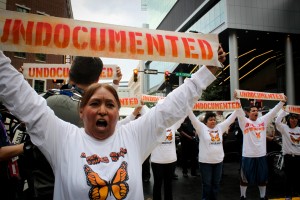
Democratic National Convention – Charlotte, NC
Photographer: Chandra Narcia
The moment of truth for this immigrant youth movement came with a meeting in L.A. between the DREAM activists and a group of immigrant rights legal advocates from National Immigration Law Center, MALDEF, NDLON, ACLU, Advancing Justice, and other key immigrant rights groups. These lawyers drafted memos supporting the DREAM activists’ claim that President Obama could grant them deferred action. In addition, these young activists asked Professor Hiroshi Motomura, an immigration and constitutional law scholar at UCLA Law School, to draft a sign-on letter to the President outlining the arguments as to why he should seriously consider granting administrative relief for DREAM Act eligible youth. When a core group of young leaders from this DREAM activist network met with White House staff, they laid out the arguments from their strategy meetings with the lawyers, and the letter from Professor Motomura. The legal scholars and legal advocates that have been meeting with these young leaders were not present at the meeting with the White House. Instead, they stepped back to enable these youth activists to step forward. This is a great example that we must follow in our next steps with pressuring President Obama to stop the deportations and issue administrative relief, now that CIR is all but dead.
Our obligation to immigrant families requires us to use our leadership positions to amplify the visibility of community members, workers and students most impacted by the separation of families, continuing deportations and lack of access to society because of their immigration status. The collective leadership of the immigrant rights movement needs to step back and allow undocumented community leaders to assert themselves as more than just storytellers, as people who can stand and act on their own behalf. We must enable this new wave of community leadership to emerge and lead as we begin to reflect, re-analyze, and shift to new strategies that not only support alternative models but also ensures accountability to a spirit of solidarity with one another. At this pivotal moment, we have to exercise a form of leadership where we co-create the struggle for immigration reform together. If we are to develop a movement that is strong and sustainable, new leadership must emerge, and we must allow it to flourish; we must trust and embrace it.
In conclusion, as we struggle with the present failure of CIR and the dismal situation impacting immigrant families and children today, let us embrace a new approach to moving forward together. Let us create a spiritual framework of humility, compassion and respect that will provide for a more cohesive collective strategy and a stronger movement as we continue the fight for immigrant rights The reality we are facing today is a challenge for all of us to express and share our spirituality with one another with the hope of making the struggle for immigrant rights compassionate, fulfilling, caring, and healthier for all of us. It is time for us to free up the spirituality inside of us, let it come out, and allow it to become a way for our hearts to connect and create true solidarity.
Follow Victor on twitter @NarroVictor
Read Victor’s piece on Law@theMargins: Perspectives: Worker Centers and the AFL-CIO National Convention – Law at the Margins http://bit.ly/14DckG7

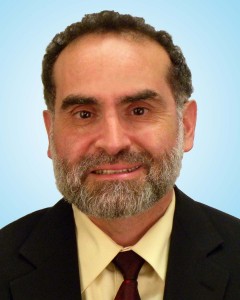
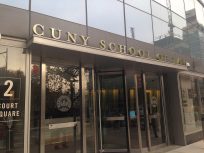
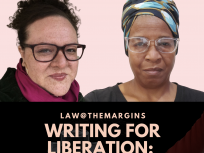


Prerogatives of the Peoples: Principles and Demands
In today’s times, when so much inhumanity, racism and political animosity clouds the debate on what principles should guide a “just” immigration policy for the US government, we of the Comités de Defensa del Barrio are determined to bring forward into the public discussion on this issue, the perspective of our families, communities, and organizations of Indigenous Peoples.
http://cdb-tonatierra.blogspot.com/2014/07/prerogatives-of-peoples-principles-and.html